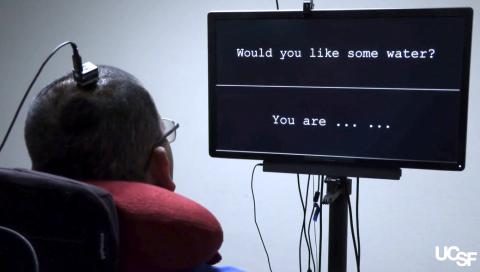Beyond Words: Device Helps Paralyzed Man Communicate

Photo: Chang lab, UCSF, NEJM
Researchers developed a device to decode brain activity into words in real time, allowing a person with paralysis to communicate in complete sentences. Part of an NIDCD-supported project, results from the study’s first participant appeared in the New England Journal of Medicine.
“This is an important technological milestone for a person who cannot communicate naturally, and it demonstrates the potential for this approach to give a voice to people with severe paralysis and speech loss,” said co-lead author Dr. David Moses of the Weill Institute for Neuroscience at the University of California, San Francisco.
With previous brain-computer interfaces that help people who cannot articulate speech to communicate, the user must spell out messages one letter at a time. An interface that let the user generate whole words at a time would allow much more efficient and natural communication.
The first participant, a 36-year-old man identified as “Bravo-1,” has been severely paralyzed for 16 years. The researchers implanted an array of electrodes onto a part of his brain that includes regions implicated in speech processing.
During a series of training sessions, Bravo-1 attempted to say each of 50 vocabulary words and sentences with these words many times. The electrodes recorded the brain activity associated with each attempt and transmitted it to a computer.
The researchers used machine learning to recognize patterns in the brain activity and associate these with the word the user was trying to say. A predictive text algorithm provided an “autocorrect” function like that used in texting.
To test the device, Bravo-1 attempted to say sentences using the 50-word vocabulary while the device decoded his brain activity in real time. The system decoded about 15 words per minute on average. Speech-decoding approaches become usable when the error rate is below 30 percent. For this system, the error rate was about 25 percent.
The team is working to increase the size of the vocabulary and the rate of speech. They also plan to conduct follow-up trials with more participants.—Brian Doctrow, NIH Research Matters
